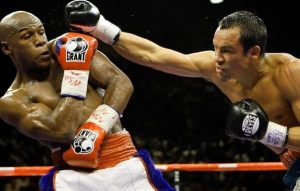Boxing Slip And Rip: Boxers frequently use the slip-and-tear manoeuvre. This approach has been quite effective for boxers in the ring, such as two-time heavyweight champion Mike Tyson.
One of the rare moves that may be used both offensively and defensively is the slip and rip, which is a basic technique in boxing. When you become proficient at this move, you’ll be able to block an opponent’s blows and position yourself to throw strong blows.
A Complete Guide About Boxing Slip-and-Rip

Let’s examine in further detail how each of the many motions that make up the technique functions separately so you can grasp the slip and rip properly.
Slipping
Slipping is a defensive motion in which you shift your head and body slightly to the side in order to deflect an impending blow. A boxer can duck under a looping attack by slipping backwards or to their left or right to escape direct strikes.
A good slip should be performed with minimum movement, just enough to allow your opponent’s blow to go over your head. The secret to doing slips correctly is quick movements that are determined by precise timing. When it comes to sliding, there’s a sweet spot that each fighter needs to discover for himself. If you slide too much, you lose your equilibrium; if you slip too little, you wind up taking a punch.
Ripping
The counterpunch that is delivered right after a punch has successfully slipped is referred to as “ripping.” Using a rip, you aim to take advantage of holes in your opponent’s defence before they can raise their arm to retaliate.
When it comes to ripping punches after slipping an assault, many boxers like to utilise hooks; however, straight punches and uppercuts can also be employed, depending on the target’s distance and angle. The “slip and rip” is the term used by boxers to describe the successful execution of a slip and rip.
You might also be interested in reading this: 3 Muscle Groups Enhanced by Boxing
The Principles Of Slipping
After discussing the concept of slipping and ripping punches, let’s examine the mechanics needed to carry out the slip:
With your knees slightly bent and shoulder-width apart, take a boxing stance. Ensure that your weight is split equally between your legs.
When you notice a punch heading towards your head, move your head laterally to the left or right, depending on which direction the blow is coming from. During the exercise, engage your torso and hips and move as quickly as you can.
As you sidestep their blow, keep your eyes open the entire time. It is more difficult for you to take advantage of counterpunching possibilities when you are unable to see your opponent.
Until you’re comfortable dodging punches launched at full speed, practise sliding blows. When you begin sliding drills, have a coach or training partner fire slow punches at you. Gradually pick up the pace. The most proficient defensive boxers in history, like Floyd Mayweather, train until they can do sliding drills automatically.
Methods for Ripping
When attempting to launch a counterattack after successfully dodging a blow, bear the following points in mind:
When it comes to tearing following a slip, timing is crucial. The moment you let go of the punch, you should strike. If you delay too long, your opponent will have more time to regroup and mount a defence.
When choosing your counterpunch, take into account the distance between your opponent and the type of punch you are countering. For example, an orthodox boxer can counter a jab by going to the outside and shooting a cross.
When you tear, use your hips and legs to provide extra force. Throw counterpunches with malice since they usually land the cleanest in boxing fights. The bout between Ryan Garcia and Gervonta “Tank” Davis serves as the ideal illustration of this. Davis slipped to the outside and delivered a devastating hook to Garcia’s head, earning him his first knockdown of the match.
When throwing your counter, keep your non-punching hand in the appropriate defensive stance. A cunning fighter may attempt to block your countermove.
Learning How To Slip-And-Rip

You may try the following to get better at slipping and ripping in the boxing ring:
- Shadowboxing: When you practise your shadowboxing routines, slide and rip. Visualise impending strikes and, following a successful rip, respond with the proper punch.
- Focus Mitts: Boxers frequently utilise them as an additional tool to hone their counterpunching and defensive techniques. During your glove workouts, your boxing teacher or training partner might fire blows for you to slide and rip.
- Sparring: The opportunity to slip and tear at full speed is known as sparring. Realistic scenarios are presented to you so that you may practise when to slip and when to rip while facing an opponent who is attempting to throw a punch at you.
Mistakes To Avoid
When learning the slip-and-rip, you should strive to avoid making some of the following mistakes:
- When sliding, try not to go too far from the centerline as this may throw you off-balance and open to counterpunches.
- Try not to give away that you’re about to slip. That’s easier said than done, though, since skilled fighters will fake to test how you’ll block their blows. If you become too dependable, your opponent will just land the punch where they anticipate you to be.
- It is important to always keep your defence in mind while using moves like the slide and rip. When you slide, keep your hands up, and as soon as you tear, bring your striking hand back to your guard.
- Develop the habit of sliding and tearing with your eyes fixed on your opponent at all times. This facilitates your ability to take advantage of holes in their defence and facilitates your defence against counterattacks and follow-up strikes.
Incorporate The Slip-And-Rip Into Your Boxing Arsenal
The slip-and-rip is an effective self-defence technique that is as valuable outside of the boxing ring. Fighters in other combat sports, such as Mixed Martial Arts and Muay Thai, also commonly utilise this tactic.
You may close distances on opponents with great effectiveness by combining your offence and defence using the slip-and-rip method. If you get the hang of this method, opponents will have a much tougher time dealing with you.

